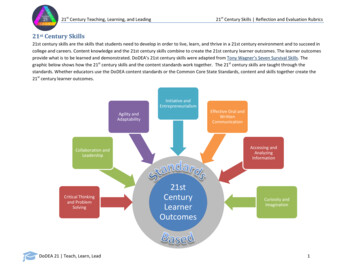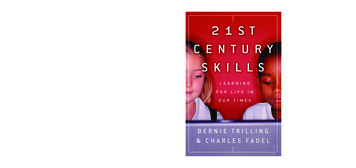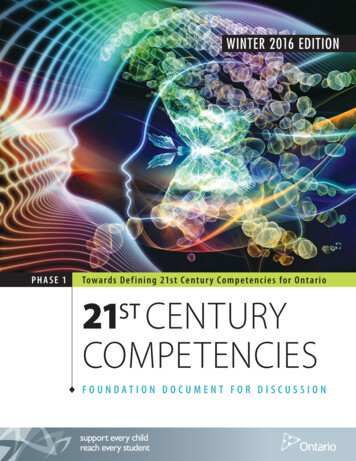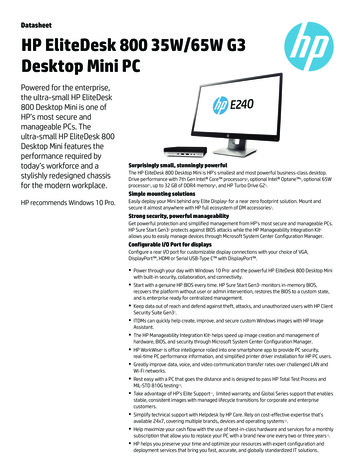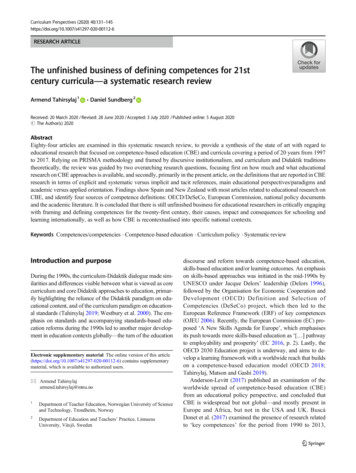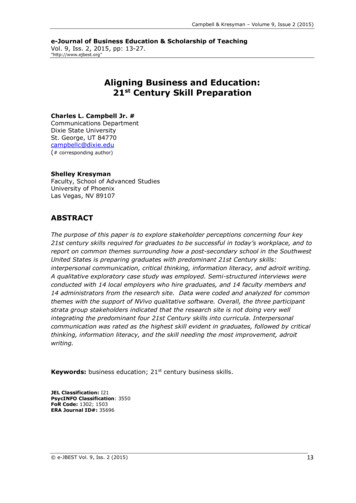
Transcription
Draft White Paper 1Defining 21st century skillsMarilyn Binkley, Ola Erstad, Joan Herman, Senta Raizen, Martin Ripleywith Mike RumbleThe Assessment and Teaching of 21st Century Skills project was created by Cisco, Intel andMicrosoft and launched at the Learning and Technology World Forum 2009 in London. During2009, the project operated with five Working Groups, each of which produced a White Paper. Thesepapers will be fully edited into a volume that will be published electronically on the project website(www.atc21s.org). Print publication is also being considered.As a report to the Learning and Technology World Forum 2010 in London, final drafts of the papersare collected together in this set and posted on the project website for Forum participants andothers who can freely access them on the website. These drafts are not for formal citation. Allpersons registered on the project website for updates will be advised when the final publication hasbeen posted on the site.January 2010NOT for quotation in this draft formi
Assessment and Teaching of 21st Century Skills project draft White PapersiiNOT for quotation in this draft form
ContentsTable of ContentsContents . iiiTable of Contents . iiiList of tables . ivList of figures . ivList of boxes . ivAbstract .vDefining 21st century skills .1The role of standards and assessment in promoting learning .2The importance of standards that promote learning .2Assessment systems that promote learning .3The nature of quality assessment systems .4Learning-based assessment systems.4Improving the quality of assessment systems .5Principles for 21st century standards and assessments.6Using technology to transform assessment and learning .7Assessment priorities enabled by information and communication technology .7The migratory strategy with ICT .9The transformational strategy with ICT .10Arriving at a model 21st century skills framework and assessment .13Existing 21st century skills frameworks .13Personal learning & thinking skills – The national curriculum for England .14The KSAVE model .15Ways of thinking .16Creativity and Innovation .16eSCAPE .17Critical thinking, problem solving and decision making .17Primum.19World Class Tests.19The VPA Project .19Learning to learn and metacognition .20eVIVA .20Cascade .21Ways of working .21Communication .21Collaboration and teamwork .23Tools for working .24Information literacy.27ICT literacy .28Living in the world .29Citizenship, global and local .30Life and career .31Personal and social responsibility.33Challenges .33Using models of skill development based on cognitive research .34NOT for quotation in this draft formiii
Assessment and Teaching of 21st Century Skills project draft White PapersTransforming psychometrics to deal with new kinds of assessments .34Making students’ thinking visible.34Interpreting assisted performance .34Assessing 21st century skills in traditional subjects .35Accounting for new modes of communication .35Including collaboration and teamwork .35Including local and global citizenship.35Ensuring validity and accessibility.35Considering cost and feasibility .36White Paper 1 Annex: Expanded descriptions of assessment tasks .37UK ICT Test for 14-year-old students .37eSCAPE .41Primum Computer-based Case Simulations (CCS) for licensing doctors.47World Class Tests .55Virtual Performance Assessment.59References and further reading .63List of tablesTable 1: Sources of documents on 21st century skills .14Table 2: Ways of thinking - creativity and innovation .16Table 3: Ways of thinking - critical thinking, problem solving, decision making.18Table 4: Ways of thinking - learning to learn, metacognition .20Table 5: Ways of working - communication .22Table 6: Ways of working - collaboration, teamwork.23Table 7: Tools for working - information literacy .25Table 8: Tools for working - ICT literacy.27Table 9: Living in the world - citizenship, local and global .30Table 10: Living in the world - life and career .32Table 11: Living in the world - personal and social responsibility .33List of figuresFigure 1: Integrated assessment system .4Figure 2: The dimensions of e-assessment innovations .8List of boxesBox 1: Innovative UK assessment of ICT skills of 14-year-olds.11Box 2: Educational Testing Service framework for ICT literacy .28ivNOT for quotation in this draft form
AbstractThis paper synthesizes research on the role of standards and assessment in promoting learning,describes the nature of assessment systems that can support changes in practice, Illustrates theuse of technology to transform assessment systems and learning, and proposes a model forassessing 21st century skills.Large-scale assessments should be only part of any system to support student learning,Assessments at each level represent a significant opportunity to signal the important learning goalsthat are targeted by the broader system as well as to provide valuable, actionable data for policyand practice. Moreover, they can model next generation assessments that can support learning. Todo so assessments should a) be aligned with the development of significant 21st century goals, b)be adaptable and responsive to new developments, c) be largely performance-based, d) add valuefor teaching and learning by providing information that can be acted on by students, teachers, andadministrators, e) meet the general criteria for good assessments, (i.e. be fair, technically sound;valid for purpose, and part of a comprehensive and well-aligned system of assessments at all levelsof education)The model for assessments of 21st century skills, based on an analysis of curriculum andassessment frameworks for 21st century skills developed around the world, identifies ten importantskills in four broad categories. The paper provides measureable descriptions of the skills,considering knowledge, skills, and attitudes, values and ethics (advanced as the KSAVEframework).The paper concludes with a discussion of challenges to be addressed in developing an assessmentsystem that supports learning using, for example, research-based models of skill development andassessments that make students’ thinking visible to establish their strengths and weaknesses andhelp shape future learning choices.NOT for quotation in this draft formv
Defining 21st century skillsMarilyn Binkley, Ola Erstad, Joan Herman, Senta Raizen, Martin Ripleywith Mike RumbleThere has been a significant shift in advanced economies from manufacturing to emphasizinginformation and knowledge services. Knowledge itself is growing ever more specialized andexpanding exponentially. Information and communication technology is transforming the nature ofhow work is conducted and the meaning of social relationships. Decentralized decision-making,information sharing, teamwork and innovation are key in today’s enterprises. No longer canstudents look forward to middle class success in the conduct of manual labor or use of routine skills- work that can be accomplished by machines. Rather, whether a technician or a professionalperson, success lies in being able to communicate, share, and use information to solve complexproblems, in being able to adapt and innovate in response to new demands and changingcircumstances, in being able to marshal and expand the power of technology to create newknowledge and expand human capacity and productivity.Research during the last decade has shown how new social practices evolve due to increased useof new digital technologies, especially among young people (Buckingham & Willett, 2006). Suchpractices create re-conceptions of key skills, not defined from a systems level, but from theeveryday lives of people in our societies. One example is research done on computer games andonline communities (Gee, 2007), where problem solving is defined as a key component of suchpractices. Such experiences of problem solving among young people need to inform us in the waywe design assessment tasks and define key skills. Hence, new standards for what students shouldbe able to do must replace the basic skills and knowledge expectations of the past. To meet thischallenge schools must be transformed in ways that will enable students to acquire thesophisticated thinking, flexible problem solving, collaboration and communication skills they willneed to be successful in work and life. New conceptions of educational standards and assessment,the subject of this white paper, are a key strategy for accomplishing the necessary transformation.Such standards and assessment can both focus attention on necessary capacities and provide datato leverage and evaluate system change. Technology too serves as both a driver and lever for thetransformation.In the sections that follow, we Synthesize research on the role of standards and assessment in promoting learning, Describe the nature of assessment systems that can support changes in practice and usethese to develop guiding principles for the design of the next generation assessments, Illustrate the use of technology to transform assessment systems and learning, and Propose a MODEL for assessing 21st century skills.Our intent is to learn from the past as we prepare for new futures in educational standards andassessment. While we provide a list of 21st century skills based on our analysis of twelve relevantframeworks drawn from a number of countries (see p.13), these serve as an example of how tothink about assessing 21st century skills. We expect that educators, as they consider our model,may need to make adaptations that fit their own contexts as they design assessments appropriatefor their own schools and students.We have organized the ten skills we have identified into four groupings as follows:Ways of Thinking1. Creativity and innovation2. Critical thinking, problem solving, decision making3. Learning to learn, MetacognitionNOT for quotation in this draft form1
Assessment and Teaching of 21st Century Skills project white papersWays of Working4. Communication5. Collaboration (teamwork)Tools for Working6. Information literacy7. ICT literacyLiving in the World8. Citizenship – local and global9. Life and career10. Personal & social responsibility – including cultural awareness and competenceThe role of standards and assessment in promoting learningThe importance of standards that promote learningWorldwide research has established the significant role that curriculum standards and assessmentcan play in molding new expectations for learning. Although the terminology of standards-led reforminitially may have been associated with accountability and improvement initiatives in the UnitedStates (e.g., New Standards Project, 1998, No Child Left Behind ACT, 2001 ), the approach haswidespread currency in educational systems as far spread as England, Germany, Norway,Singapore and Australia to name just a few. The basic ideas followed by these accountability andschool improvement systems have rested on three principles: Be clear about expectations by establishing standards; Develop high visibility (sometimes referred to as high stakes) assessments based on thestandards; and Use the assessments to communicate what is expected, to hold relevant stakeholdersaccountable and to publish data to inform decisionsSuch standards-based assessments provide empirical evidence for judging performance and canserve a variety of decision-making purposes (accountability, selection, placement, evaluation,diagnosis, or improvement) but the very existence of the assessments and the attention theyengender carry important social, motivational and political consequences.Researchers around the globe studying such assessments have found fairly uniform effects. This isdocumented by a number of examples: studies of state accountability assessments in more than adozen states in the United States, of A- or GCSE or Key Stage Exams in England, and of languageand higher education admissions testing programs in countries such as Australia, Central andEastern Europe, China, Hong Kong, Israel, Japan, New Zealand and Sri Lanka document that. Insummary: Assessments signal priorities for curriculum and instruction; high visibility tests serve tofocus the content of instruction. School administrators and teachers pay attention to whatis tested, analyze test results, and adapt curriculum and teaching accordingly. Teachers tend to model the pedagogical approach reflected on high-visibility tests. Whenhigh visibility assessments are composed of multiple-choice items, teachers tend to relyheavily on multiple-choice worksheets in their classroom instruction and emphasize lowerlevel cognitive skills. However, when the assessments use extended writing and/orperformance assessments, teachers incorporate similar activities in their classroompractice. Curriculum developers, particularly commercial interests, respond to important tests bymodifying existing textbooks and other instructional materials and/or developing andmarketing new ones to address test expectations. These products in turn may becomeprimary resources that influence practice and also influence teachers’ understandings oftest expectations.2NOT for quotation in this draft form
White Paper 1: Defining 21st century skillsAt the same time research documents effects that can propel productive changes in practice,so too it shows the potential for substantial negative consequences. Schools and teachers tend to focus on what is tested rather than underlying standards orlearning goals, and to ignore what is not tested. Both the broader domain of the testeddisciplines and important subjects that are not tested may get short shrift. In the UnitedStates, England and other countries, tests tend to give relatively little attention to complexthinking and problem solving and tend to focus on lower levels of learning, which can leadto similar emphases in classroom practice. Focusing on the test, rather than underlying learning, may encourage a one-timeperformance orientation and transmission-type teaching. When doing well on the test,rather than learning, becomes the goal, schools may unwittingly promote a performanceorientation in students, which in turn can work against students’ engagement andpersistence in learning, metacognition, and self regulation. Especially for high visibilitymultiple-choice tests, teachers may concentrate on helping students acquire specificcontent, rather than helping students build conceptual understandings and problemsolving capabilities. Instructional/teaching time is diverted to specific test preparation activities. Schoolsprovide students with practice on the specific types of tasks and formats that are expectedon the test, through commercial test preparation packages, special classes andhomework. Such activities aim specifically to help students do well on the test, rather thanpromoting students’ learning, and depending on the school and the pressure to improvetest scores, can divert weeks or more of instructional time.These consequences and caveats underscore an important challenge in using assessments topromote 21st century skills. The research clearly shows that whatever is measured matters; thateducators tend to model and mimic in their curriculum and instruction the content and format of highvisibility assessments and to use a significant amount of classroom time for special test preparationactivities. In some countries, however, testing has become dominated by routine, and highlypredictable items, which are also often short and highly scaffolded, thus reducing the expectationthat students should apply knowledge, skills and broader capabilities demanded by today’s world.For example, analyses of annual state, standards-based tests in the United States show apreponderance of items addressing lower level cognitive demand to the detriment of complexthinking and problem-solving applications (see Webb, 1999). Other countries provide morepromising examples. For instance, end of secondary school/University access examinations suchas the Baccalaureat, the Matura, Abitur, etc. probe in depth the content and skills that students areexpected to acquire and call on students to demonstrate their knowledge and skills in a wide varietyof oral and written formats and project-based work. And in the Nordic countries there is a tradition ofintegrating project work into the curriculum promoting more locally adapted and general standardsfor assessment. Such examples involve students in important, authentic performances. Even so,the assessment standards for these exams have not yet been fully updated to reflect the demandsof an information and innovation age, nor do they take advantage of 21st century technology. Justas students need to be literate in new media and be able to harness their power, so too technologycan open up new, cost-effective possibilities for the design and use of a new generation ofassessments.Assessment systems that promote learningThe contrast between US-type accountability exams and promising, secondary and universityaccess examinations also is noteworthy in that the latter are embedded in coursework rather thanexternal to it, where they can become an integral part of the teaching and learning process. Theexams establish meaningful goals on which course assignments and assessments can be built andare used regularly to assess and respond to student progress. Research, in fact, shows thepowerful effect that on-going assessment, so called formative assessment, has on student learning,particularly for low ability students (Black and Wiliam, 1998; OECD, 2005).NOT for quotation in this draft form3
Assessment and Teaching of 21st Century Skills project white papersFigure 1: Integrated assessment systemThe use of assessment information is key to the idea: to be considered formative, assessmentevidence must be acted upon to inform subsequent instruction. Rather than focusing backward onwhat has been learned, formative assessment helps to chart the learning road forward, byidentifying and providing information to fill any gaps between the learners’ current status and goalsfor learning. Moreover, more than solely a source of evidence that informs subsequent teaching andlearning, carefully crafted formative assessments can directly support the learning process byincorporating principles of learning and cognition (Herman & Baker, 2009; Bennett & Gitomer,2009). For example, by asking students to make public their thinking, formative probes can providescaffolding that helps students confront their misconceptions, refine and deepen theirunderstandings and move to more sophisticated levels of expertise (refs). By asking students forexplanations and providing practice over multiple and authentic contexts, assessment tasks canhelp students to connect new knowledge to their existing structures and build transfer capability. Bymaking learning goals explicit and involving students in self -assessment, formative assessmentalso can promote students as agents in their own learning, increasing student motivation,autonomy, and metacognition, as well as learning. Such characteristics similarly can beincorporated into accountability assessments to increase their learning value.The nature of quality assessment systemsLearning-based assessment systemsAssessment design and development must bring together the rich, existing research base onstudent learning and how it develops with state of the art psychometric theory to produce a newgeneration of assessments. As a prominent panel in the United States put it:Every assessment rests on three pillars: a model of how students represent knowledge anddevelop competence in a subject matter domain; tasks or situations that allow one to observestudents’ performance; and an interpretation method for drawing inferences from theperformance evidence thus obtained (Pellegrino et al., 2001, p. 2).Adapting this general model, Figure 1 is intended to communicate that quality assessment starts(and ends) with clearly specified and meaningful goals for student learning (see also Baker, 2007;Forster & Masters, 2004; Wilson & Sloane, 2000). The assessment task vertex signals that any4NOT for quotation in this draft form
White Paper 1: Defining 21st century skillslearning-based assessment must elicit responses that can reveal the quality of studentunderstandings and/or where students are relative to the knowledge and skills that compriseintended learning goals. The interpretation link reinforces the idea that responses from assessmenttasks must be specially analyzed and synthesized in ways that reveal and support valid inferencesthat connect to intended uses of the assessment, while the use vertex highlights that results mustbe used for student learning relative to initial goals. Assessment quality then resides in the nature ofthe relationships between and among all three vertices and their connections -- in the relationshipbetween learning goals and tasks used to assess their development, in how well the analysis andscoring schemes capture important dimensions of intended understandings and skills and how wellthey support use are used to improve learning. Inherent here too are the more traditionaldimensions of validity, accuracy and fairness of interpretations of student learning and--particularlyfor external and higher stakes tests--evidence that interpretations and inferences are justified (seeWhite Paper 2).As Figure 1 shows, there are multiple levels for which data may be gathered and used for variousdecision-making purposes, from on-going data to inform and enrich classroom teaching andlearning (see White Paper 4) to periodic data to support policy and practical decision-making athigher levels of the educational system – e.g., school, district, province or state, national.Importantly, large scale international, national and/or state or provincial assessments, for example,may provide policymakers a general barometer for judging and responding to schools’ progress inpromoting student learning, for allocating resources, identifying locales that need help, etc. Schoolsand teachers may use the same data to evaluate their programs, refine their curricula, frameimprovement plans, and/or identify individual students who need special attention. But to fuel ongoing decisions to optimize teaching and learning, teachers need a more continuous flow of data.Figure 1 implies a system of assessments, grounded in a common, well-specified set of learninggoals, that is purposively designed to satisfy the decision-making needs of all actors within andacross the educational enterprise. Such a system needs to be aligned with the 21st century skillsthat will enable students’ future success. Large-scale assessments can serve an important functionin communicating and signaling what these skills are as well as provide important models of howthey can be assessed.Improving the quality of assessment systemsThis system perspective also requires a different vantage point for considering assessment quality.Rather than focusing only on a single test, we need to consider the quality of the system forproviding valid evidence to support the varied decision-making needs at multiple levels of theeducational system. Balanced assessment seems an over-riding criterion (Bell, Burkhardt & Swan,1992). Pellegrino et al. (2001), for example, argued for the development of balanced assessmentsystems to serve both accountability and policy purposes as well as those of improving classroomteaching and lear
Defining 21st century skills Marilyn Binkley, Ola Erstad, Joan Herman, Senta Raizen, Martin Ripley with Mike Rumble The Assessment and Teaching of 21st Century Skills project was created by Cisco, Intel and Microsoft and launched at the Learning and Technology World Forum 2009 in London. During
